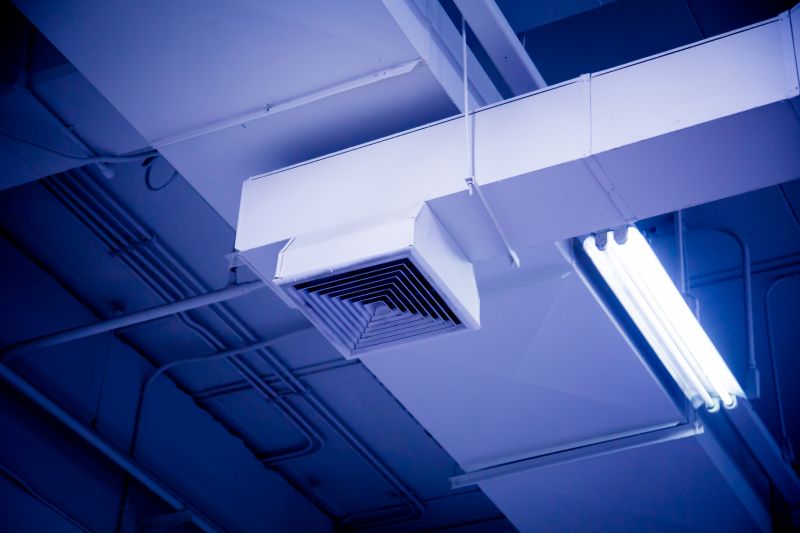Popular Solutions For Warehouse Exhaust Fan Installation Projects
Explore a range of reliable products designed to simplify installation and enhance ventilation performance in commercial warehouses.
 Warehouse exhaust fan installations are essential components for maintaining proper airflow and ventilation in large commercial or industrial spaces. These systems help to remove heat, fumes, dust, and other airborne contaminants, contributing to a safer and more comfortable working environment. Selecting the right products for installation involves understanding various fan types, sizes, and accessories to ensure optimal performance and safety.
Warehouse exhaust fan installations are essential components for maintaining proper airflow and ventilation in large commercial or industrial spaces. These systems help to remove heat, fumes, dust, and other airborne contaminants, contributing to a safer and more comfortable working environment. Selecting the right products for installation involves understanding various fan types, sizes, and accessories to ensure optimal performance and safety.
Top Overall Option
Heavy-Duty Industrial Exhaust Fan
A robust industrial exhaust fan designed for large-scale warehouse applications, offering high airflow capacity and durable construction to withstand demanding environments. Its reliable motor and corrosion-resistant materials make it suitable for continuous operation, helping to ensure effective ventilation over time.
Types of Products For Warehouse Exhaust Fan Installations
Axial Fans
Large, high-capacity fans ideal for moving significant volumes of air with minimal noise, suitable for wide-open warehouse spaces.
Centrifugal Fans
Fans that provide high pressure airflow, often used in ducted systems to direct air efficiently within confined spaces.
Inline Fans
Compact fans installed within ductwork to facilitate targeted ventilation in specific areas of the warehouse.
Exhaust Fans with Dampers
Fans equipped with dampers to control airflow and prevent backdrafts when not in operation.
Wall-Mounted Exhaust Fans
Fans designed for installation directly into exterior walls, providing easy access for maintenance and effective ventilation.
Roof-Mounted Exhaust Fans
Fans installed on the roof to exhaust heat and fumes, ideal for large warehouse facilities with high ceilings.
Explosion-Proof Fans
Specialized fans built to operate safely in environments with flammable dust or vapors, ensuring safety compliance.
Energy-Efficient Fans
Models designed to reduce power consumption while maintaining effective airflow, suitable for long-term operation.
Sound-Reduced Exhaust Fans
Fans equipped with noise dampening features to minimize sound levels in noise-sensitive environments.
Variable Speed Fans
Fans with adjustable speeds to optimize airflow based on operational needs, enhancing energy efficiency.
Duct Fans
Fans specifically designed to be integrated into duct systems for targeted ventilation within the warehouse.
Portable Exhaust Fans
Movable fans that can be repositioned as needed, offering flexible ventilation solutions for various areas.
Popular Choices
Widely used for their ability to move large amounts of air efficiently in expansive spaces.
Commonly chosen for their compact design and ability to be integrated into existing duct systems.
Popular for their ease of installation and effective ventilation in specific zones.
Frequently selected for their capacity to exhaust heat and fumes from high-ceiling warehouses.
Trending for their ability to reduce energy costs while maintaining airflow performance.
Chosen for safety in environments with combustible dust or vapors, ensuring compliance and safety.
Popular for their adjustable operation, allowing tailored airflow management.
Preferred in settings where noise reduction is important without sacrificing airflow capacity.
Favored for their flexibility and ease of repositioning across different warehouse zones.
Often used together to control airflow and prevent backdrafts when fans are off.
When considering exhaust fans for warehouses, it is important to evaluate the size of the space, the volume of air that needs to be moved, and the specific environmental conditions. Proper installation and the right accessories, such as mounting brackets and control systems, can enhance the efficiency and longevity of the ventilation system. Additionally, selecting compatible components that meet safety standards and local codes is crucial for a compliant setup.
The market offers a wide range of products designed to suit different warehouse sizes and ventilation needs. From large axial fans to more compact, energy-efficient models, there are options to fit various budgets and operational requirements. Accessories like dampers, filters, and sound attenuators can further customize the system to improve performance and reduce noise levels. Proper planning and product selection are key to achieving effective and reliable ventilation in demanding environments.
Investing in quality components and understanding the features of each product type can help warehouse managers and facility operators make informed decisions. Whether upgrading an existing system or installing a new one, the right products can contribute to a safer, more efficient workspace. Always consider compatibility, durability, and ease of maintenance when choosing products for exhaust fan installations in large industrial settings.
Key Buying Considerations
- Determine the size and volume of the warehouse to select an appropriately rated fan.
- Assess airflow requirements based on the type of contaminants or heat to be removed.
- Consider the noise levels of the fan, especially in areas where sound reduction is desired.
- Evaluate the energy efficiency features to reduce operational costs over time.
- Check for compatibility with existing ductwork or installation spaces.
- Ensure the fan's materials and construction are suitable for the environment, including resistance to corrosion or dust.
- Review safety features such as explosion-proof designs or protective grilles.
- Look into control options, including variable speed drives or remote operation capabilities.
- Consider maintenance requirements and ease of access for cleaning or repairs.
- Verify compliance with local safety and building codes relevant to industrial ventilation.
- Evaluate the durability and warranty offered by the manufacturer.
- Assess the availability of accessories like dampers, filters, or sound attenuators.
- Think about future scalability if the warehouse size or ventilation needs increase.
- Determine the power supply requirements and compatibility with the facility's electrical system.
- Review user feedback and product ratings for insights into real-world performance.
